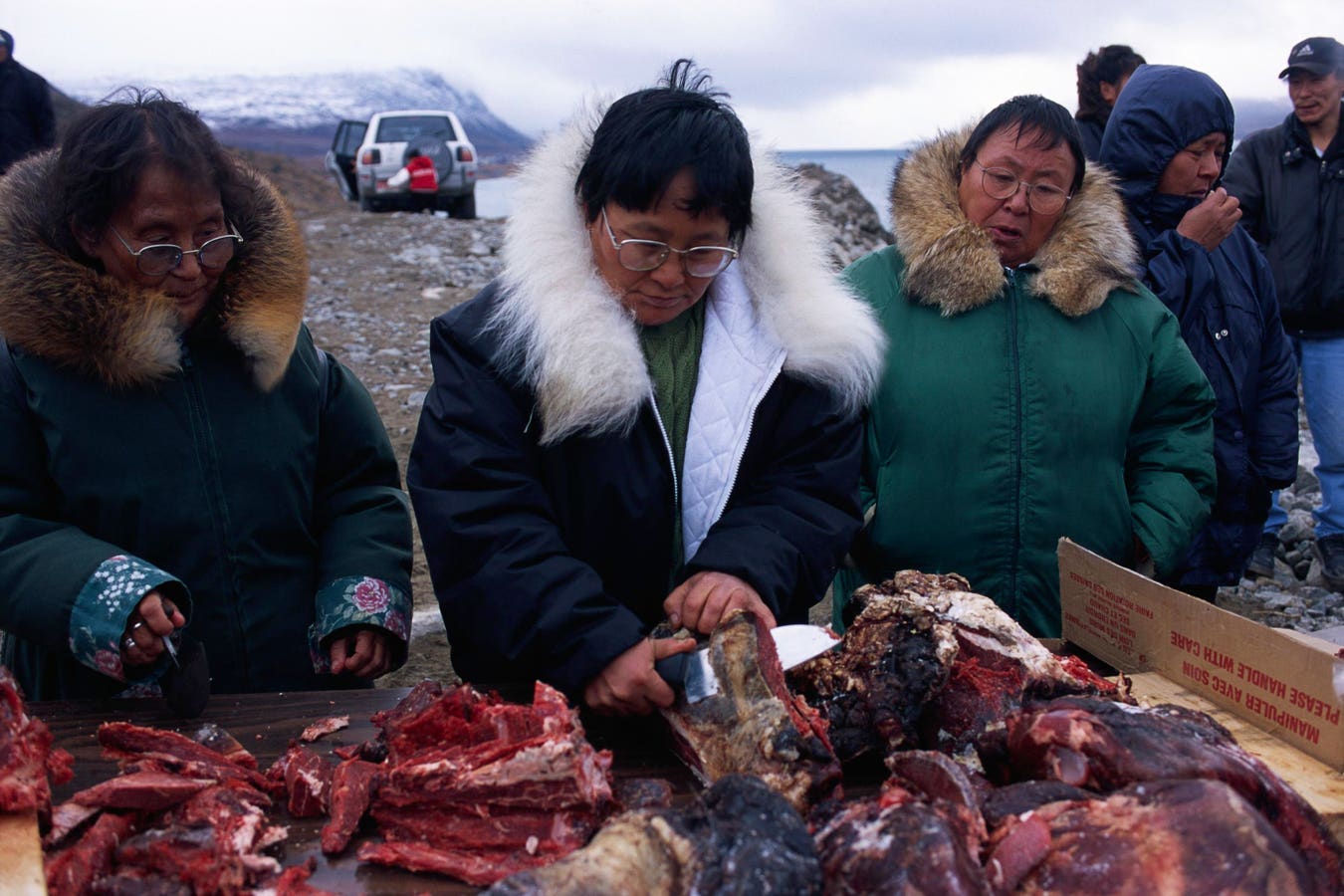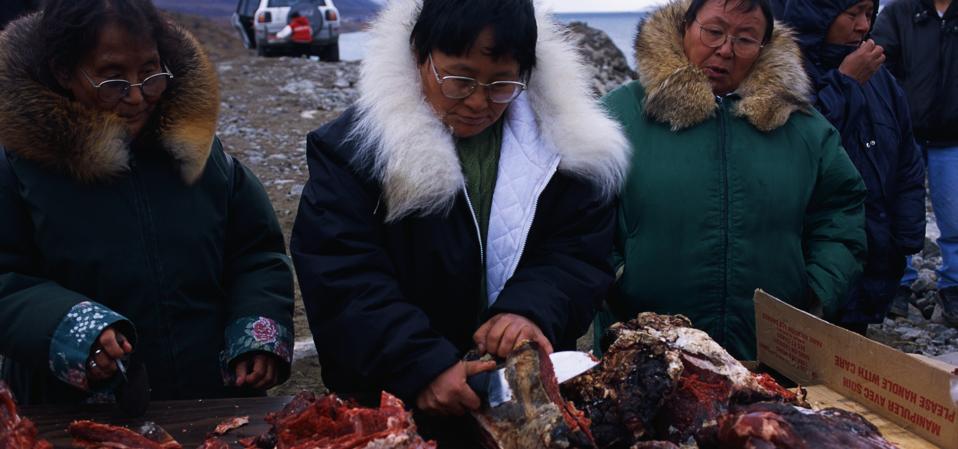Cultures vary in the extent to which they consume animal products. Some lean vegetarian. Some lean carnivore. Most are in the middle. Here are a few of the societies that make meat a true staple of their day-to-day diets.
getty
You may have heard predator species like lions, wolves and even orcas being labelled as “hypercarnivores.” Here’s the simple logic behind that tag: if an animal gets over 70% of their caloric intake directly from animal flesh, they become a part of this category. Humans, on the other hand, sit in another category — omnivores — capable of digesting animal as well as plant matter. But did you know that certain groups push the boundaries of these labels to this day?
As a biologist, I’m interested in human dietary variation across cultures and time, and how this compares to animal diets. While most modern humans don’t come anywhere near hypercarnivory, a few exceptional populations have historically reached, or come close to, that threshold. In this article, I’ll examine which human groups have approached true hypercarnivorous behavior — and what that reveals about our evolutionary roots.
What Is A Hypercarnivore, Exactly?
A hypercarnivore is an animal whose diet consists of more than 70% meat — typically by caloric intake, not just volume or frequency. What’s left can come from plant matter or other non-meat sources.
Most humans today, including most readers of this article, get a significant portion of their calories from carbohydrates — grains, tubers, legumes and fruits. But in certain harsh environments where plants are scarce, or in culturally unique circumstances, some populations have adapted to survive — often thrive — on primarily animal-based diets.
1. The Inuit (Arctic Peoples) – The Gold Standard Of Human Carnivory
When it comes to human hypercarnivory, the Inuit of the Arctic regions are arguably the most cited example. Living in one of the most plant-scarce environments on Earth, traditional Inuit diets historically consisted of up to 95% animal products. Their primary sources of food included:
- Seal and walrus blubber and meat
- Caribou
- Fish (such as Arctic char)
- Whale
- An occasional egg or seabird
Edible plants are pretty much non-existent in Arctic environments for almost the entire year, and things get worse during the long winters. How did the Inuit people find a way to survive? They developed unique metabolic adaptations to live almost exclusively on high-fat, high-protein diets. These included genetic variations in fatty acid metabolism and vitamin D synthesis.
Traditionally, Inuit diets are already not that high in carbohydrates. On top of that, they also avoid the problems associated with modern high-protein, low-carb diets because of the very high fat intake, including omega-3-rich blubber. Their lifestyle was active, their diet nutrient-dense, and until Western dietary influence arrived, they boasted relatively low rates of chronic disease.
2. The Maasai Of East Africa – Blood, Milk And Meat
With a pastoralist lifestyle centered around their cattle, the Maasai found the perfect home in the grassy plains of Kenya and Tanzania. Of course, they weren’t strictly hypercarnivorous like the Inuit, but the traditional Maasai diet remains one with some of the highest animal-product consumption in the world, deriving a large chunk of their calories from:
- Cow’s milk
- Cow’s blood
- Beef (though meat was consumed less frequently than milk and blood)
Warrior-age men of the Maasai clan could go for unnaturally long periods of time without consuming a single portion of plant-based food. Because they figured out that blood and milk provided a surprisingly complete nutritional profile, particularly when consumed fresh and unprocessed.
While the exact percentage of meat-based calories varied with season and wealth, some Maasai subgroups came close to qualifying as hypercarnivorous during certain times of the year.
3. The Mongol Empire’s Nomads – Meat, Dairy And Fermented Everything
During the height of the Mongol Empire, the nomadic horsemen of the Central Asian steppes lived on a diet that was heavily animal-based. They herded sheep, goats, yaks, and horses, and consumed:
- Mutton and goat
- Fermented mare’s milk (airag)
- Cheese, butter, and yogurt
- Blood-based broths
Starch and cultivated plants were relatively rare on the steppe. While not purely hypercarnivorous, many Mongol groups likely got over 70% of their calories from animal products during long stretches, especially when on military campaigns or in winter.
4. The Plains Indigenous Tribes Of North America – Bison-Centered Diets
Tribes such as the Lakota, Comanche, and Blackfoot, particularly in pre-colonial times, relied heavily on bison hunting. During peak bison-hunting seasons, some of these communities derived the vast majority of their nutrition from:
- Bison meat and fat
- Organ meats (liver, heart, kidneys)
- Bone marrow
- Preserved meats like pemmican (a mix of dried meat and fat)
While many of these groups also foraged for berries, roots, and wild grains when available, bison provided a calorie-dense, year-round food source, especially once preservation methods were perfected.
5. Hunter-Gatherer Cultures In Ice Age Europe
Let’s go even further back in time. Scientists have reason to believe that Upper Paleolithic humans in Ice Age Europe (particularly during glacial periods) may have been highly carnivorous. And the proof was found in the fossils. Analysis of nitrogen isotope ratios in fossilized bones suggests that some groups relied heavily on large herbivores like:
- Mammoths
- Reindeer
- Woolly rhinoceros
- Red deer
In colder climates, edible plant matter would have been seasonal or limited, and humans with hunting tools and social cooperation could dominate meat-rich environments. Some of these populations may have exceeded the 70% threshold for extended periods — putting them squarely in the hypercarnivore zone.
So… Are Humans Natural Hypercarnivores?
The answer is a no with caveats. Humans are extremely adaptable omnivores, and under certain environmental pressures, as we now know, some groups have moved toward hypercarnivory out of necessity or culture. Our evolutionary flexibility might just be our greatest dietary strength.
So does that mean that you can start your “lion diet” tomorrow? The answer here is a no without any caveat. The diets described in this story evolved under specific environmental conditions. And, unsurprisingly, often came with trade-offs. For example:
- The Inuit had high rates of parasitic infection from raw meat.
- The Maasai had vitamin A and C deficiencies due to meat and dairy exclusivity.
- Steppe nomads often experienced vitamin C deficiencies unless they consumed raw organ meats.
That said, these examples offer fascinating insights into human nutritional resilience and diversity.
While most modern humans rely on grains, vegetables, and processed foods for the majority of their calories, history reveals that certain human groups have danced with the edges of hypercarnivory. From the frozen Arctic to the windswept Mongolian steppe, necessity and environment shaped diets that leaned heavily — sometimes almost entirely — on meat.
As a biologist, I see these examples not as dietary prescriptions, but as reminders of our species’ remarkable adaptability. The human body can survive — and sometimes thrive — on a wide range of diets. But in the end, it’s context, not ideology, that determines what’s optimal.
And in a few corners of history and geography, humans came remarkably close to being true hypercarnivores.
Do you think it’s morally appropriate to consume animal products? Take the Animal Attitude Scale to see where you fall on this unique personality dimension.








